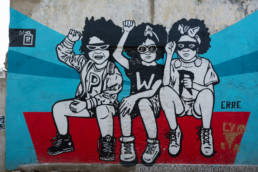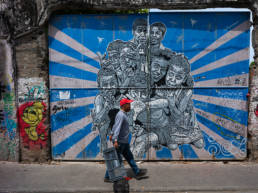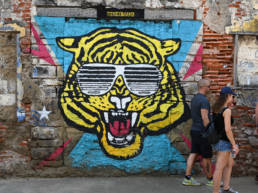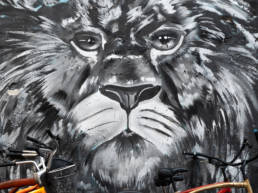Graffiti gegen Armut
Von Cornelia Schmid
Getsemaní war einst Hort von Prostitution und Drogenhandel. Durch Graffiti wurde das Quartier zu einer Galerie für Strassenkunst. Manche mögen Street Art als Verschandelung erachten, andere als eine der aussagekräftigsten Ausdrucksformen der Kunst. Sicher ist: Graffiti spricht eine universelle Sprache, die Menschen verbindet. Historisch gesehen war Getsemaní die Heimat von Bediensteten und Menschen der sonst unsichtbaren Unterschicht. Dem New York der 1970er-Jahre nicht unähnlich, bestimmten zwischen 1980 und 2000 Armut, Prostitution und Drogenhandel das Leben im Quartier. Mittlerweile ist Getsemaní zum künstlerischen Herz der Stadt herangewachsen und bietet den Kreativen eine Plattform für ihre Kunst.

l 1 l
Graffitis spiegeln die politische und kulturelle Geschichte des Landes und die damit verbundenen Probleme wider.
Graffiti reflects the political and cultural history of the country and the problems associated with it.
Getsemaní hat auch sonst so einiges zu bieten. Vor allem ein charismatisches Wohn- und Ausgehviertel. Frauen schieben schwere Gemüsekarren vor sich her und Greise sitzen vor ihren Häusern und spielen Domino. In der Calle Ancho spaziert man unter einem Dach von bunten Sonnenschirmen, auf der Plazuela del Pozo unterhalten Strassenkünstler die Menschen mit Musik. An fast jeder Ecke gibt es ausgezeichnete Restaurants, Tapas-Bars und Kulturbistros. Nach Sonnenuntergang trifft man sich auf der Plaza de La Trinidad vor der gleichnamigen Kirche oder tanzt in einem Club zu karibischer Musik. Das Viertel hat sich in eine farbenfrohe Menagerie aus Hostels und Cafés verwandelt und besticht durch sein geschäftiges Nachtleben. Im Gegensatz zur herausgeputzten Altstadt Cartagenas hat Getsemaní seinen ursprünglichen, verruchten Charakter behalten, was das Viertel besonders sympathisch macht.
Graffiti against poverty
Getsemaní was once a place of prostitution and drug dealing. Graffiti turned the neighborhood into a gallery for street art. Local artists created the first murals on Calle de la Sierpe on a drab concrete wall that served as a public restroom. They recognized the opportunity to reclaim the streets with their spray cans and imagination. Their artworks tell stories of local legends that they honor and are part of Getsemaní’s living heritage. Arguably, some of the most spectacular works are located in the narrow streets around Plaza de la Trinidad. The Afro-Colombian woman of DEXS is one of the most photographed graffiti in Getsemaní. The group of young people around DjLu is particularly impressive. Even world stars like Puerto Rican megastar Ricky Martin and Colombian singer Juanes use Getsemaní as a backdrop for their music videos. Camilo Fidel Lopez, organizer of the Urban Street Art Festival, says, «Urban art transforms a wall into a conversation space, allowing tolerance and appreciation for another’s thoughts while drawing attention to issues relevant to the community.
Die Graffiti-Szene ist in ganz Kolumbien berühmt, vor allem im modernen Bogotá. In Getsemaní leitete die Strassenkunst einen Wandel ein, bei dem die Boheme-Atmosphäre des Quartiers bewahrt wurde. Die ersten Wandgemälde entstanden in der Calle de la Sierpe auf einer eintönigen Betonmauer, die als öffentliche Toilette diente. Einheimische Künstler erkannten die Chance, die Strassen mit ihren Spraydosen und ihrer Fantasie zurückzuerobern. Ihre Kunstwerke erzählen Geschichten von lokalen Legenden, die sie ehren und die Teil des lebendigen Erbes von Getsemaní sind.
Die expressive Kunstform sorgte bei Graffiti-Fans für Aufmerksamkeit: Content Creators aus aller Welt reisten nach Kolumbien, um Mitglied dieses kreativen Schmelztiegels zu werden. Die Calle de la Sierpe ist zu einer Art Ground Zero für diese künstlerische Ausdrucksweise geworden. Einige der wohl spektakulärsten Werke befinden sich in den engen Gassen rund um die Plaza de la Trinidad. Die afrokolumbianische Frau von DEXS (Seiten 42/43) ist eines der meistfotografierten Graffitis in Getsemaní. Besonders eindrucksvoll ist die Gruppe Jugendlicher um DjLu (Seite 38), einem auf die Stencil-Technik spezialisierten Künstler. Sogar Weltstars wie der puerto-ricanische Megastar Ricky Martin und der kolumbianische Sänger Juanes nutzen Getsemaní als Kulisse für ihre Musikvideos.
Viele Bilder sind 2013 entstanden, als Getsemaní Gastgeber des International Urban Art Festival war – einer sechstägigen Veranstaltung, zu der die besten Graffitikünstler Kolumbiens eingeladen wurden. Das Festival hat seinen Ursprung in Berlin, wo die städtischen Galerien zu touristischen und kulturellen Attraktionen für Besucher geworden sind. Ähnliche Festivals fanden zuvor in Miami und Lissabon statt.
Vértigo Graffiti ist die bedeutendste Vereinigung von Graffiti-Künstlerinnen und -Künstlern in Kolumbien. Das Team aus professionellen Malern, Grafikerinnen, Fotografen und Content Creators nutzt den öffentlichen Raum, um mit ihrer Kunst auf ihre Anliegen hinzuweisen und den Dialog zwischen Menschen zu ermöglichen. Camilo Fidel Lopez, Direktor von Vértigo Graffiti und Organisator der Festivals, sagt: «Urban Art verwandelt eine Mauer in einen Gesprächsraum, ermöglicht Toleranz und Anerkennung für die Gedanken eines anderen, während sie gleichzeitig die Aufmerksamkeit auf Themen lenkt, die für die Gemeinschaft relevant sind.» Seit dem ersten Urban Street Art Festival sind weitere Projekte entstanden, die jungen Menschen eine Zukunftsvision vermitteln.
Graffiti against poverty
Getsemaní was once a place of prostitution and drug dealing. Graffiti turned the neighborhood into a gallery for street art. Local artists created the first murals on Calle de la Sierpe on a drab concrete wall that served as a public restroom. They recognized the opportunity to reclaim the streets with their spray cans and imagination. Their artworks tell stories of local legends that they honor and are part of Getsemaní’s living heritage. Arguably, some of the most spectacular works are located in the narrow streets around Plaza de la Trinidad. The Afro-Colombian woman of DEXS is one of the most photographed graffiti in Getsemaní. The group of young people around DjLu is particularly impressive. Even world stars like Puerto Rican megastar Ricky Martin and Colombian singer Juanes use Getsemaní as a backdrop for their music videos. Camilo Fidel Lopez, organizer of the Urban Street Art Festival, says, «Urban art transforms a wall into a conversation space, allowing tolerance and appreciation for another’s thoughts while drawing attention to issues relevant to the community.

l 2 l

l 3 l

l 4 l
Urban Street Art
Nach Sonnenuntergang trifft man sich in Getsemaní auf der Plaza de La Trinidad vor der gleichnamigen Kirche zu einem kühlen Bier oder schlendert durch die umliegenden Strassen un bewundert Urban Street Art:
- Plazuela del Pozo
- Calle de la Sierpe
- Calle de San Antonio
- Calle San Juan
After sunset, people meet in Getsemaní on the Plaza de La Trinidad in front of the church of the same name for a cool beer or stroll through the surrounding streets and admire urban street art:
- Plazuela del Pozo
- Calle de la Sierpe
- Calle de San Antonio
- Calle San Juan

l 5 l

